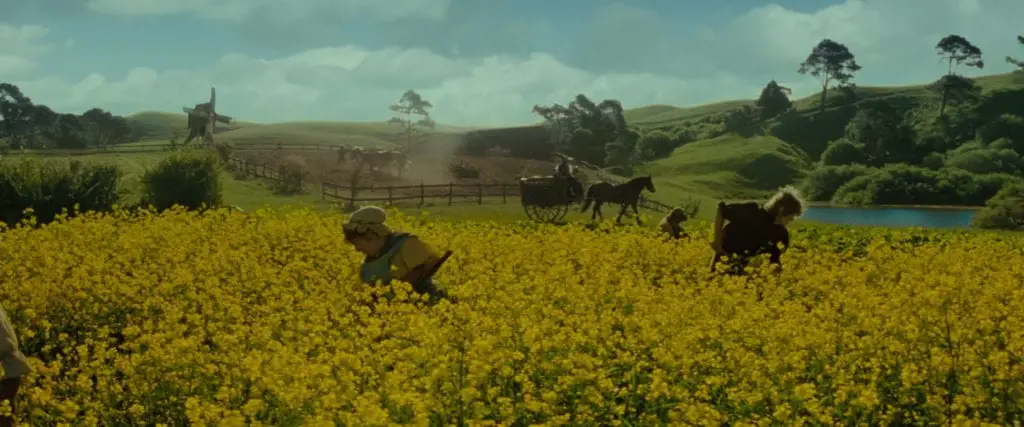Before we get into the specifics of Peter Jackson’s 2001 The Fellowship of the Ring let’s all take a moment to appreciate how wild it is that this movie exists, in the form that it does.
Take a look at the box office totals for the years leading up to 2001. Fantasy movies pretty much don’t exist. The nineties were a wild time at the box office, where disaster movies and romantic comedies duked it out for box office supremacy. Take 1998. The box office champions for the year were Saving Private Ryan, Armageddon, and There’s Something about Mary. Collectively, they grossed just shy of $600,000,000. The closest thing I can find to a fantasy movie that came out this year was The Mask of Zorro, taking in around $90M and Ever After, making around $65M. It wasn’t a fluke: 1996 topped out with Independence Day ($306M), Twister ($241M), and Mission Impossible ($181M). The only fantasy movie that year was Dragonheart, a Dennis Quaid and Sean Connery vehicle that just cracked $50M. It looked like this:

This period – 1996-1998 was when Lord of the Rings was taking shape in Peter Jackson’s imagination and getting into studio development. The three films together were given a budget just shy of $300M. The director was a relatively unknown guy from New Zealand, whose previous background largely consisted of horror movies whose budget occasionally managed to surpass 1% of The Lord of the Rings’s budget. Given the current situation, each film would have to be one of the most successful of the year to be considered a profitable movie, something relatively unprecedented for live action fantasy films. The fact that this worked is crazy.
It did work, of course, and the sort of movies that top off the box office really seem to pivot around the year 2001. I’m not saying that The Fellowship of the Ring paved the way for the modern movie landscape. It would be a silly statement to make, given that Harry Potter and the Sorcerer’s Stone came out the same year and that Spider-man was waiting in the wings for a 2002 release. But Jackson’s trilogy redefined what was possible for big-budget fantasy films made for adults. The fact that he insisted on taking the story seriously – at a time when he was a b-movie director and fantasy stories were turned into children’s or b-movie films – was a brave and audacious thing to do. That’s easy to forget fifteen years down the line.
Of course it’s never a great sign when you begin a movie review with “Guys, guys: it could have been so much worse.” But I think that these days PJ doesn’t get enough credit for taking this story totally seriously, pulling in actors like Ian McKellan through sheer passion for the project alone, and making what must have been a tough, tough sell to studio executives. There are flaws here, of course. We’re gonna get to them in a second. But this was a brave movie to make. Flaws and all, it deserves its title as one of the best fantasy films that’s been created.
Thank God for Weta Workshop
Let’s start with the good. This movie is absolutely beautiful. We all know by now that New Zealand is a pretty place, and a lovely Middle-earth:
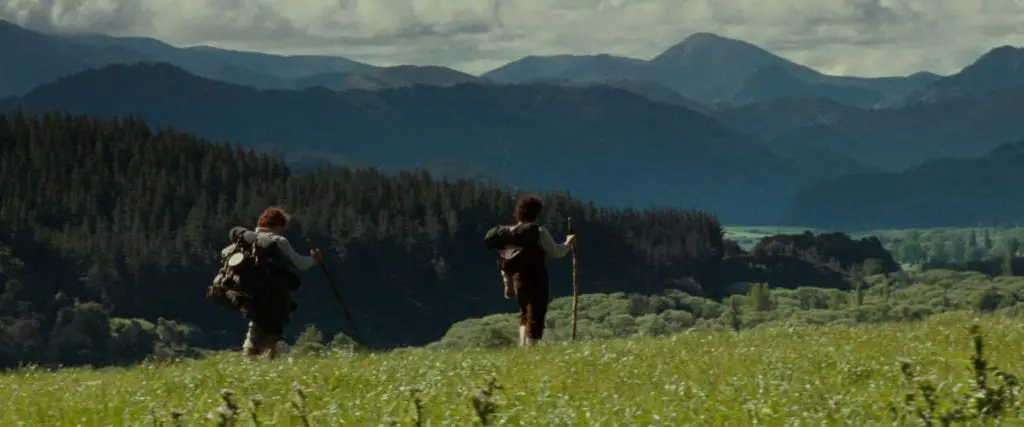
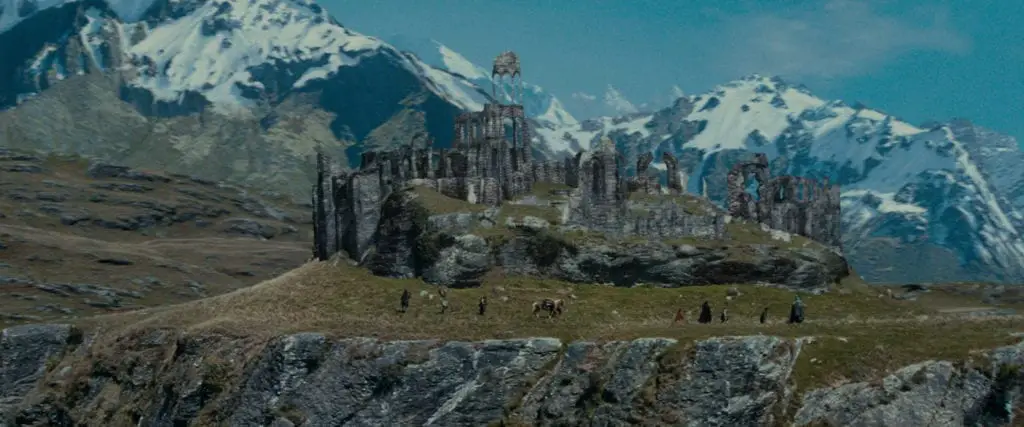
But the film is so beautifully detailed too. It’s nice to go back and watch how clever and meticulous PJ (or PJ’s team) was before he spiraled down, power mad, into the terrible CGI pit from which he has yet to emerge. Everything here, though! That scene at the Council of Elrond? Jackson wanted it outside, so crew members collected bags of leaves, individually painted them, and then laid on rafters and dropped them down onto the scene. The chain mail is made by hand, to the extent that the two dudes who crafted it lost the finger prints on two fingers. There are two versions of Bag End – one hobbit-sized and one Ian-McKellan-sized – that are identical down to having the same books on the shelves in the same order. I mean, just look at all the beautiful, unnecessary details on Boromir’s clothing!
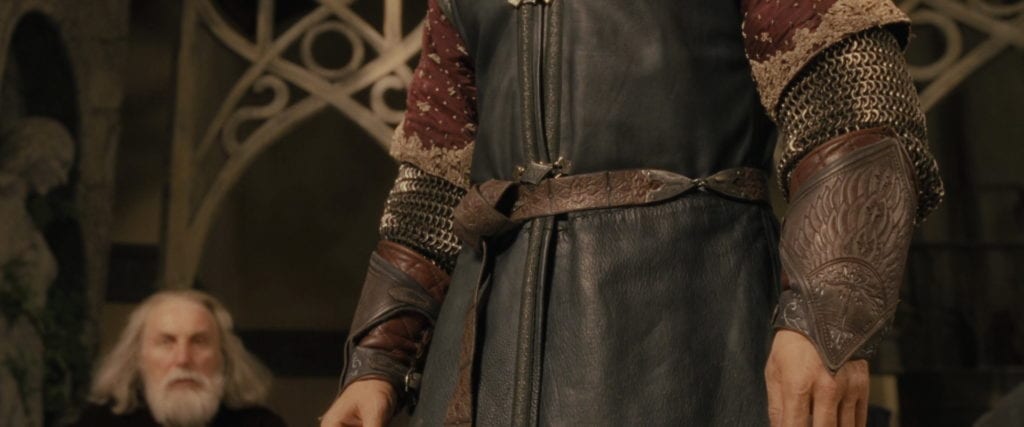
The movie looks almost perfect in all of its physical aspects (though I’d give some side-eye to Lórien, which is too blue-toned and too ominous, and more on that in a bit). There’s so much care and craft on display here, and I will always point frantically to this movie and its sequels when I need to insist that miniatures and makeup look better than CGI.
The Cast and the Characters
If you ever want to feel thankful for something, this is it: Sean Connery was offered the part of Gandalf; Nicholas Cage was offered the part of Aragorn. Just imagine that world.
I’d argue that the cast of The Fellowship of the Ring is pretty much perfect. I get that the hobbits are all wrong on paper, with Elijah Wood being too young by several decades and the other hobbits then being relatively too old. But the four of them have an immediate camaraderie and verve to them that I really like, despite some characterization issues I’ll get to in a bit. The rest of the Fellowship is perfectly cast, and I am willing to fight anyone, anytime about that fact. They are all international treasures.
When we hit characterization, though, we start to run into a few more issues.
Let’s start with our hobbits. I wouldn’t argue that any of them are wrong, but they are condensed in ways that will be fine with some and not-so-fine to others. Frodo is not quite the Frodo of the books – his Tookish side is nowhere to be found and he’s a passive character, all curly hair and GIANT SAD EYES.
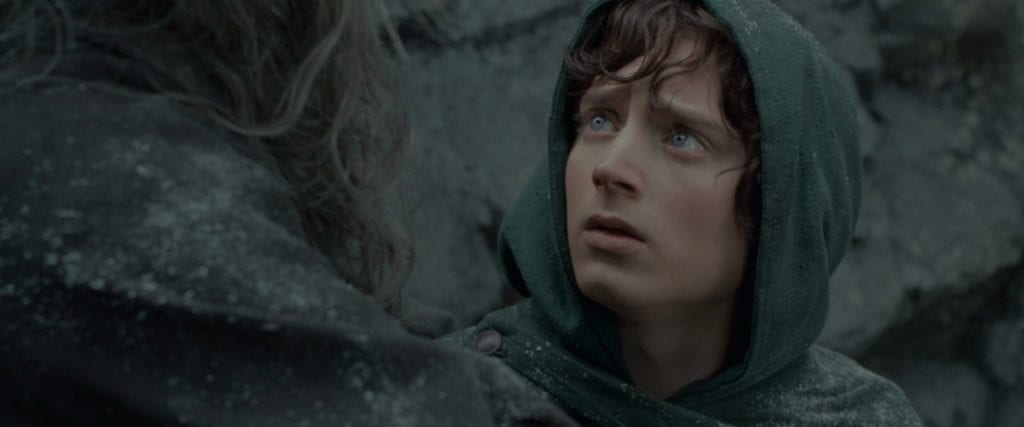
I get criticisms of this, but it honestly doesn’t bother me that much. I quite like movie!Frodo even though he’s a different character than we find in the books. Every character we see here, except perhaps Gandalf, gets distilled down to one point or another, in order to introduce and develop a cast of 10-12 characters. Frodo is very passive and quiet for most of the movie. He often looks bewildered and in-over-his-head. Fair enough! And I’d argue that the choice to focus on this character trait leads to the movie’s two most successful moments: Frodo’s choice to take the Ring at the Council of Elrond and his choice to go to Mordor alone on the banks of the Anduin.
Our other hobbits get streamlined as well. They all lose quite a bit of their intelligence in the process, often at the expense of some comic relief. Now, Peter Jackson has his strengths. Master humorist is not one of them. Merry and Pippin manage to get by most of the time because Dominic Monaghan and Billy Boyd are so genuinely delightful together, but it does make me sad that the attempts at humor will sometimes undermine their characters. I mean, Pippin’s “so where are we going?” at the end of The Council of Elrond is cute and innocuous enough. But it does make me sort of sad that we lose Pippin’s insistence that he accompany the Fellowship despite his (limited) understanding of what they’ll be doing.
Sam’s probably even worse. His loyalty is all there, but if he’s not Mr-Frodo-ing about something he’s either staring blankly at Rosie Cotton or eating food. Sam is intelligent in his own way in the books, and he’s certainly curious and emotionally observant. Most of that is unfortunately lost in translation.
Gandalf is perfect. So is Bilbo.
For the most part, I think Aragorn and Boromir are well done, given the constraints of adaptations. Aragorn is a little too mopey and his romance with Arwen – after a pretty good first scene, I’d argue – stagnates quickly. He’s insecure in a noble, brooding way rather than a snippy, prickly way, which I’d argue is a step in the wrong direction. He’s also, much as I’m not complaining, probably far too pretty. Still, Viggo Mortensen just settles into this character so easily that I’m sort of on board anyway.
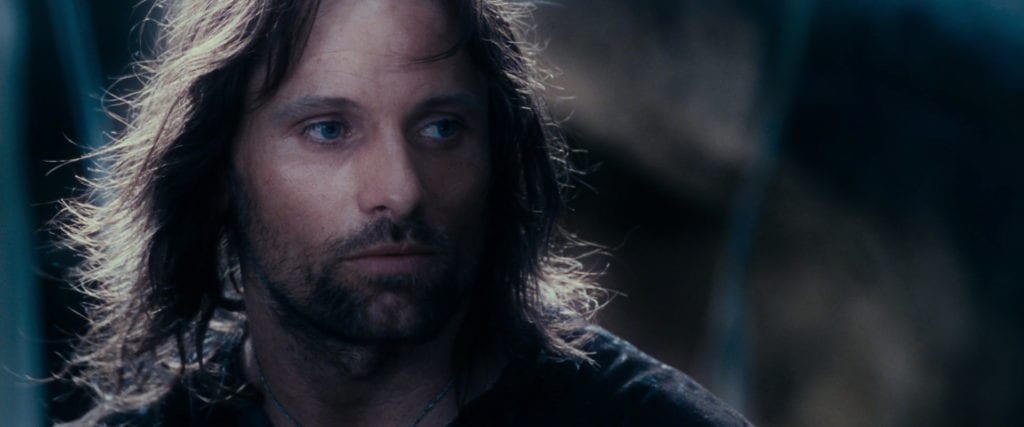
Sean Bean is an A+ Boromir. But by emphasizing Boromir’s fascination with the Ring over his obsession with Gondor, we lose a little of his nuance. It’s a flaw throughout Jackson’s films. The Ring exerts magic on people in very overt ways. If they fail, it’s as if they’ve been “possessed” by the Ring, rather than giving into a fault like pride or fear or despair. It makes the story less morally interesting, I think. It’s part of a general simplification that’s present throughout the films. And it does bug me a bit. But movie Boromir works in his own context, I think, largely because of Sean Bean’s performance. He’s jumpy and proud, but a good guy, and I still find his death scene really affecting.
The only characters that I really have a problem with are the Elves. There are things about them that I think Peter Jackson gets right. There’s a sadness that permeates their story, and a sense of nostalgia. I remember appreciating that when I first saw the trilogy, assuming it would be ignored or cut. But in playing that up, I think PJ often portrays them as too alien or too antagonistic. There’s a sense of majesty and distance, to the Elves, sure. But it’s often dialed up to 11 in The Fellowship of the Ring, to the extent that magic shifts into something overwrought or tacky.
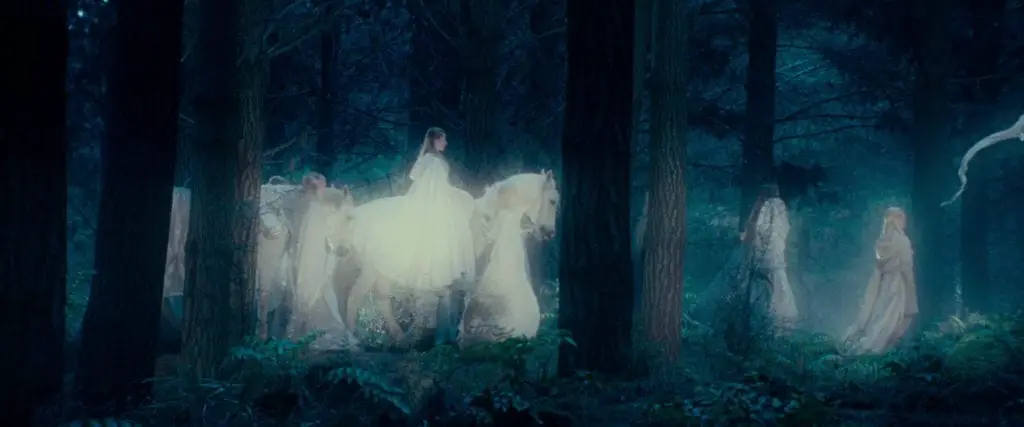
And on the personal level, Elrond and Galadriel never really work for me. Elrond is really sweet in the books, one of the only Elves who isn’t immediately a dick to the hobbits. Here he’s all angry eyebrows and gloomy pessimism, yelling at Gandalf about the weakness of men. And Galadriel loses most vestiges of her humanity. She spends most of her time casting uncomfortable looks at people and actively emitting light. It’s an awkward, uncomfortable portrayal of Elves and their brand of magic. It’d be a tough thing to capture cinematically, of course. But Jackson’s attempt has never worked for me.
From Book to Movie
But how does The Fellowship of the Ring work as an adaptation? It’s a tough question that deals in so many hypotheticals that it’s hard to definitively answer. But I’d argue that it works fairly well, under the circumstances. It’s a simplified version of the story found in Lord of the Rings, in terms of plot, character, and theme. It’s often heavy-handed. But Jackson & Co. were working to adapt a story that is terrifically difficult to adapt to the expectations of modern cinematic audiences.
The biggest issue is an issue of time. The Extended Edition of Fellowship of the Ring clocks in at just over three hours and twenty minutes and I’d argue that the vast majority of scenes still feel somewhat rushed. Take the early part of the movie, as the hobbits flee the Shire. Merry & Pippin smash into Frodo and Sam, they see a Black Rider, they run to Bree, they meet Aragorn, they trust Aragorn, they’re at Weathertop. It already feels dangerously close to a checklist, the narrative version of “first they went here, then they went there, then they met him, then they went here…” I don’t think it’s an anomaly that one of the best scenes in the movie – the very end, the Breaking of the Fellowship – is one that given a long time to unfold.
It’s why I’m not all that sympathetic to the arguments made by people angry at things being left out. I’d love to see the Barrow-Downs or the Old Forest. But I’m glad they aren’t here. They would have made the movie worse. And Bombadil? I’d love to see someone try it. But I wouldn’t trust Peter Jackson with Bombadil with a ten-foot pole (sorry PJ, buddy, love you). The movie is already bending a bit at the seams, and is often too streamlined for its own good. There was a lot of pressure from the studios to turn this into a single film, and I can only imagine what a disaster that would have been.
It also suffers a little from literalism and heavy-handedness. The worst offender is probably Sauron becoming a literal eye of fire, who transmogrifies into a fiery-eye-lighthouse by The Return of the King. But even beyond that – when he’s not in his fiery eye form he’s stomping around his lava lair in spike armor. If that’s not enough, his scene ends in a majestic screen wipe of fire.
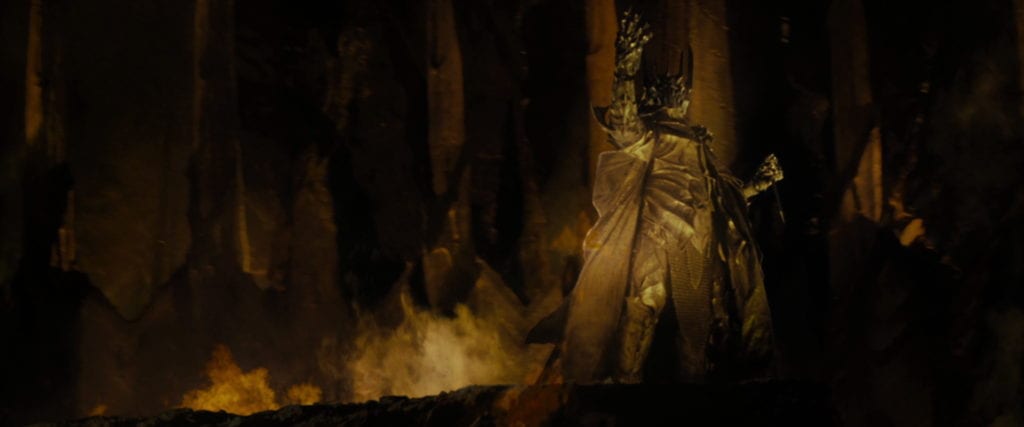
The hobbits in the Shire are dumb country bumpkins, scratching their ears and shoving food into their faces. Elves are ethereal, so they glow a lot and move slowly. Arwen threatens to become an interesting lady in the movie, but backs off and just glows prettily instead. We hear about threats from Saruman, so we have to repeatedly go check in on him building his orc army. There’s a compulsive need to make everything visible and literal. I get that to a certain extent. Film is a visual medium. But storytelling is about what you choose not to show as much as what you choose to show. And Jackson wants to show everything, but lacks the time to show everything well.
Final Comments
- Much as I love it, I could nit-pick this movie endlessly. Thank God I watched it alone. After furiously scrawling three pages of notes during the prologue I gave up and just yelled commentary at my screen. “Concerning Hobbits” shoulda stayed cut, PJ! What’s wrong with you? Aww, but the Shire is so pretty. And Gandalf is perfect. It’s okay.
- The beginning of this movie is probably the biggest info-dump I can possibly imagine, but I honestly don’t mind it. Cate Blanchett sells it, and there are lots of loving close ups of beautiful maps.
- But on that note, if you want to talk about any particular scene, I will be there with opinions.
- Howard Shore is a godsend to this movie. Go listen to “The Breaking of the Fellowship” and feel all your feelings. I have nothing negative to say about the scoring of any of The Lord of the Rings.
- I had such a crush on Orlando Bloom with I saw this when I was thirteen. He always just makes me laugh, now, though I think he’s a great casting choice. He looks like such a pretty boy, which fits well with book-Legolas.
- Why does the CGI Balrog look better than any of the CGI in The Hobbit films?
- Speaking of that, do any of you still wonder what would have happened if Guillermo Del Toro actually did direct The Hobbit? I think about that every day.
- Happy New Year! We’ll start of The Two Towers the “The Departure of Boromir” on January 12th
All screenshots are courtesy of New Line Cinema. The still from Dragonheart is courtesy of Universal Pictures.


